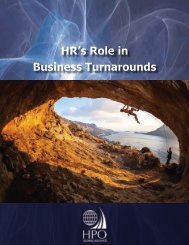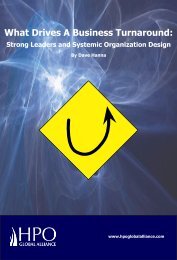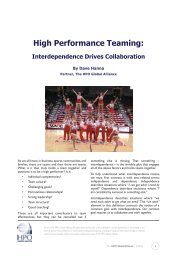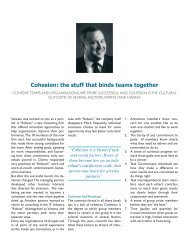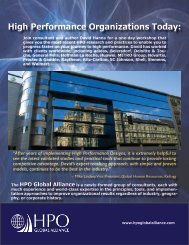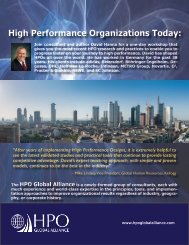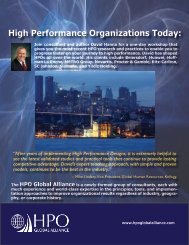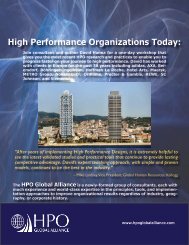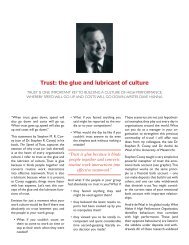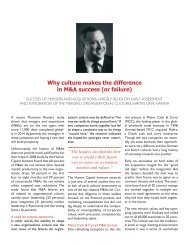Org Survival Code & Lifecycles
Create successful ePaper yourself
Turn your PDF publications into a flip-book with our unique Google optimized e-Paper software.
The <strong>Org</strong>anizational <strong>Survival</strong> <strong>Code</strong>:<br />
Avoiding The Slippery Slope of High Performance<br />
www.hpoglobalalliance.com<br />
The HPO Global Alliance ©2015 1
THE ORGANIZATIONAL SURVIVAL CODE:<br />
Avoiding The Slippery Slope of High Performance<br />
Dave Hanna<br />
The HPO Global Alliance<br />
Many organizations are on the endangered species<br />
list in this 21st century. This is not a personal opinion,<br />
but a statement of fact based on patterns of the<br />
past 100 years.<br />
An Endangered Species<br />
For starters, condider this question: what do the<br />
following companies have in common?<br />
• Cambria Steel<br />
• Guggenheim Exploration<br />
• Lehigh and Wilkes-Barre Coal<br />
• Intercontinental Rubber<br />
• Schwarzchild and Sulzberger<br />
• Central Leather<br />
Each of these institutions was one of the top 100<br />
U.S. firms in 1909 1 , but none exists today as an independent<br />
entity. They are either out of business or a<br />
very minor player in some larger corporation. Some<br />
were quite large in their glory days (Central Leather<br />
was number seven on the 1909 list). Unfortunately,<br />
they were not able to maintain their success. In a<br />
few management generations they have disappeared.<br />
These six are certainly not unusual: of the top 100<br />
U.S. industrial firms in 1909, only 14 are still in the<br />
elite group today. Only 23 are still around at all!<br />
Now fast forward to today’s Fortune Top 100 list.<br />
Let’s consider global companies, not just those<br />
in the USA. The table below is most instructive.<br />
The left column lists some representative leaders in<br />
the Global 100. The right column identifies some wellknown<br />
companies who fell off of the list during the<br />
decade of the 2000-2009. These companies were not<br />
alone. In fact, 55 of the Top 100 fell off the list during<br />
the 2000s. And 55 companies also fell of the list in the<br />
decade of 1990-99. Going back to the original list of<br />
1909, a review of the Top 100 during the decade 1909-<br />
1919 shows 41 of those companies fell off the list. So<br />
regardless of the era, staying on top of the pack is hard<br />
to do.<br />
No doubt, many of the organizations who have slipped<br />
also have been busily engaged re-strategizing and redesigning<br />
some aspects of their operation. But, what<br />
good is any organization design if the organization itself<br />
fails to maintain its competitive advantage?<br />
FORTUNE’S TOP 100 GLOBAL COMPANIES<br />
2014 Leaders Casualties of the 2000s<br />
• Walmart (1) • Mitsubhishi<br />
• Roytal Dutch Shell (2) • Boeing<br />
• Sinopec (3) • Credit Suisse<br />
• China National Petro (4) • Unilever<br />
• Exxon Mobil (5) • Sears Roebuck<br />
• Volkswagen (8) • DuPont<br />
• Toyota (9) • Philips Electronics<br />
• Apple (15) • Merrill Lynch<br />
• McKesson (29) • Hyovereinsbank<br />
• Nestlé (72) • Enron<br />
• Procter & Gamble (92) • BASF<br />
The HPO Global Alliance ©2015 2
Consider further the reasons the companies fell off<br />
the list from 1909-1919:<br />
• Changing economic conditions<br />
• Mergers and acquisitions<br />
• Emergence of new technologies<br />
So what has changed in 100 years? Not much. Roughly<br />
50% of the Top 100 fall within 10 years for the same<br />
fundamental reasons. This common pattern for the<br />
past century indicates there are some systemic forces<br />
at play here, not just a series of coincidences or random<br />
events.<br />
The struggle for life isn’t something peculiar to<br />
large corporations. The Office of Advocacy of<br />
the U.S. Small Business Administration (SBA) reports<br />
that 99.7 percent of new employer establishments<br />
are small firms. The 2014 Bureau of the<br />
Census report for the SBA indicated 66 percent of<br />
new firms survived two years, 50 percent survived<br />
five years, but only 33 percent survived 10 years. 2<br />
A 2014 study by the Brookings Institution indicated<br />
that, for the first time since it began tracking<br />
startups and closures in 1978, U.S. businesses were<br />
collapsing faster than they were being formed. 3<br />
The same principles that sustain a natural ecosystem<br />
for centuries also can enable an organization<br />
survive in our global economy.<br />
I have applied the main principles of ecosystem survival<br />
into what I call the <strong>Org</strong>anizational <strong>Survival</strong> <strong>Code</strong>:<br />
1. Ecological Order: strategize to meet your<br />
stakeholders’ most critical needs.<br />
2. Purpose: develop a sense of purpose that<br />
each member instinctively follows.<br />
3. Steady State: develop processes and systems<br />
that consistently deliver high quality<br />
results.<br />
4. Mobilization: solve problems at their<br />
source.<br />
5. Complexity: grow in skills and flexibility.<br />
6. Synergy: develop true partnerships with all<br />
stakeholders.<br />
7. Adapt, Adapt, Adapt: re-strategize and<br />
redeploy your resources as circumstances<br />
require.<br />
Why is it that with all our technical advances, with<br />
our unparalleled capacity to learn and store knowledge,<br />
with the coming of reengineering, balanced<br />
scorecards and lean production—why is it with all<br />
this going for us we are unable to build organizations<br />
that can hold up over time? One wonders if<br />
any system can survive more than a few decades…<br />
But don’t give up just yet. There is light at the end of<br />
this tunnel.<br />
The <strong>Org</strong>anizational <strong>Survival</strong> <strong>Code</strong><br />
While organizations struggle today, the most enduring<br />
systems on the planet are found in nature. Earth’s<br />
oldest life forms are California’s redwood trees. Ecosystems<br />
of mountains, forests, streams, meadows,<br />
insects, and animals are amazingly resilient. These<br />
systems can survive physical calamities, destructive<br />
weather patterns and other major environmental<br />
shifts and endure for centuries unless humans intervene<br />
and attempt to “civilize” them. What these natural<br />
systems have in common with your organization<br />
is that they are both living systems, meaning some<br />
of their key elements are living, breathing entities.<br />
The HPO Global Alliance ©2015 3
The companies who consistently follow the survival<br />
code will have all the business they want. They are the<br />
few true high performers who overcome the dynamics<br />
of the slippery slope of high performance.<br />
Stora Enso: The World’s Oldest<br />
Industrial Company<br />
A good example of the <strong>Org</strong>anizational <strong>Survival</strong> <strong>Code</strong><br />
in action is Stora Enso, generally regarded as the oldest<br />
industrial company in the world. 4 Throughout its<br />
eight-plus century history, this business enterprise has<br />
adapted successfully to changing world conditions.<br />
It merged with Finland’s Enso Oyj in 1998 and today<br />
is the world’s second largest pulp and paper manufacturer.<br />
Through each of its adaptive phases, Stora Enso<br />
has revised its purpose, established a steady state to<br />
produce new products, mobilized resources, developed<br />
complex skills in new businesses and synergized<br />
with new partners to enable it to stay on top. Stora’s<br />
13th century copper mines have long since exhausted<br />
their resources, but the company lives on, with 30,000<br />
associates in 85 units on all continents still making a<br />
significant contribution to the quality of life for many<br />
of us.<br />
<strong>Survival</strong> Is Earned<br />
“Nothing comes from nothing” says the German proverb.<br />
An organization’s demise is not a coincidence or<br />
random bit of bad luck. It is the logical consequence<br />
of practices that place it out of harmony with its<br />
stakeholders and the market environment. High performance<br />
and survival are the natural consequences<br />
of actions and processes that align with the <strong>Org</strong>anizational<br />
<strong>Survival</strong> <strong>Code</strong>.<br />
A document in 1288 first mentioned the existence of<br />
Stora Kopperberg, a Swedish copper mining enterprise<br />
operating under the direction of the Swedish crown,<br />
nobility, and foreign merchants. In medieval times, this<br />
company supplied copper for many purposes, most<br />
notably the construction of ships and cathedral steeples<br />
throughout Europe. Stora was a major contributor<br />
to the Swedish economy.<br />
Through the centuries as technology and lifestyles<br />
evolved, Stora’s business has adapted successfully from<br />
mining to pulp and paper manufacturing and wood<br />
products today.<br />
References<br />
1<br />
A. D. H. Kaplan study in Big Enterprise in a Competitive<br />
System, Brookings Institution, 1954.<br />
2<br />
2014 U.S. Bureau of Labor Statistics<br />
3<br />
“U.S. Businesses are being destroyed faster than they are<br />
being created,” The Washington Post, May 5, 2014.<br />
4”<br />
Sweden: The oldest corporation in the world,” Time<br />
Magazine, March 15, 1963.<br />
The HPO Global Alliance ©2015 4





